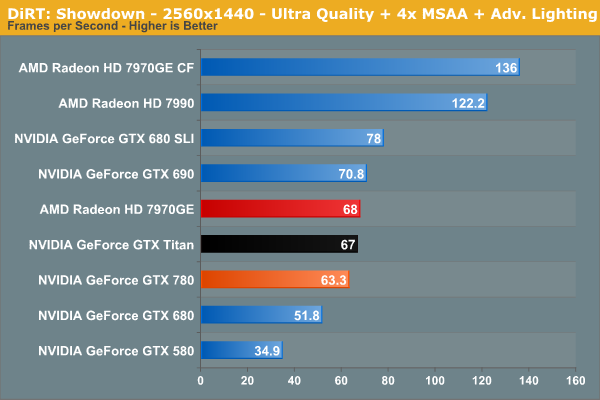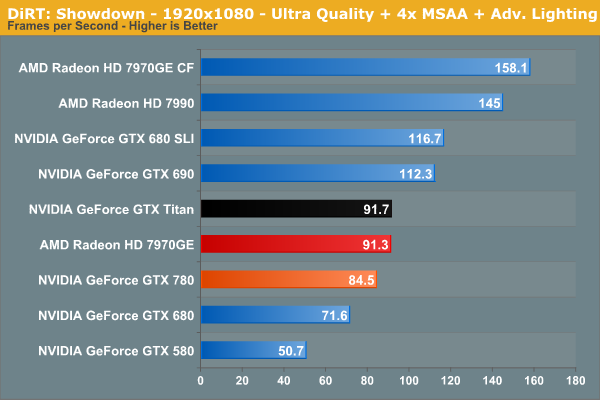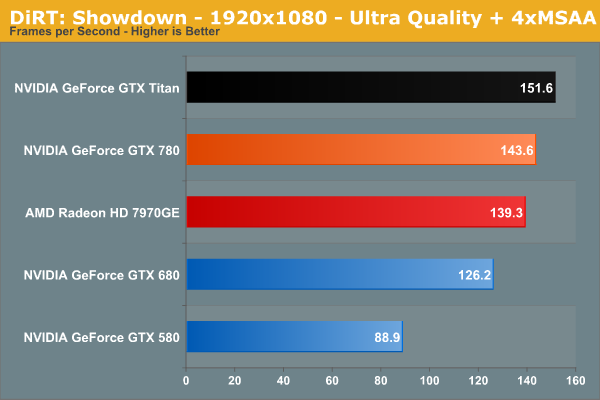NVIDIA GeForce GTX 780 Review: The New High End
by Ryan Smith on May 23, 2013 9:00 AM ESTDiRT: Showdown
As always, starting off our benchmark collection is our racing benchmark, DiRT: Showdown. DiRT: Showdown is based on the latest iteration of Codemasters’ EGO engine, which has continually evolved over the years to add more advanced rendering features. It was one of the first games to implement tessellation, and also one of the first games to implement a DirectCompute based forward-rendering compatible lighting system. At the same time as Codemasters is by far the most prevalent PC racing developers, it’s also a good proxy for some of the other racing games on the market like F1 and GRID.




DiRT: Showdown’s lighting system continues to befuddle us at times. Though GK10x Kepler parts generally have mediocre compute performance in pure compute tasks, NVIDIA’s DirectCompute performance has otherwise proven to be appropriately fast, except in the case of DiRT. The fact of the matter is that DiRT is easy enough to run even with its advanced lighting system that there’s no reason not to use it on a card like the GTX 780 at any single-monitor resolution, but doing so does put the GTX 780 in a bad light relative to AMD’s best cards. Nor does this put GK110 in a particularly good light, as its compute enhancements don’t bring it much of an advantage here beyond what the larger number of shaders affords.
Like Titan before it, the GTX 780 falls slightly behind AMD’s Radeon HD 7970 GHz Edition, the only such benchmark where this occurs. The end result being that the GTX 780 trails the 7970GE by about 7%, and the GTX Titan by 6%. Otherwise we’ve seen Titan (and will see GTX 780) do much better in virtually every other benchmark.










155 Comments
View All Comments
varad - Thursday, May 23, 2013 - link
You do realize that a GPU like Titan has almost 5 times the number of transistors compared to Intel's biggest Core i7 CPU, right? There are 7.1 billion transistors in Titan vs 1.4 billion in Core i7 3770k. So, it means they cannot match the price of "a good CPU" unless they decide to become a non-profit organization :)AssBall - Thursday, May 23, 2013 - link
Well if all you needed was a single titan to run your is, computations, games, and nothing else, then no problem.krutou - Sunday, May 26, 2013 - link
Two problems with your logic22 nm fabrication is more expensive (price per transistor)
CPUs are more difficult to design
An00bis - Friday, May 31, 2013 - link
it's not like you can just shove your hand in a jar full of transistors and just slap it on a chip and consider it a cpu, a cpu is required to do a gpu's task (integrated gpu) AND be good at everything a gpu can't do, which is... well lots of things actually. A gpu is much simpler, hence why the manufacturing + designing cost is probably more expensive than a big ass card that has to include memory+a pcb+a gpuchizow - Thursday, May 23, 2013 - link
Great card, but a year late. This is what GTX 600 series should've been but we all know how that went.I think Nvidia made some pretty big mistakes with how they handled the entire Kepler generation after Tahiti's launch price debacle. I know their financial statements and stockholders don't agree but they've managed to piss off their core consumers at every performance segment.
Titan owners have to feel absolutely gutted at this point having paid $1000 for a part that is only ~10-15% faster than the GTX 780. End result of this generation is we are effectively paying 50-100% more for the same class of card than previous generations. While the 780 is a great card and a relatively good value compared to Titan, we're still paying $650 for what is effectively Kepler's version of the GTX 470.
Crisium - Thursday, May 23, 2013 - link
People who bought a Titan knew what they were getting into. If you have regrets, you were in no position to buy a $1000 GPU to begin with and made a grievous financial error.$650 isn't horrible for this price, but you are still paying the Nvidia Tax.
chizow - Thursday, May 23, 2013 - link
I don't think so, if you polled GTX Titan owners if they would've paid $1000 knowing 2-3 months later there would be a part that performed similarly at 35% less price, I think you would hear most of them would've waited to buy not 1, but 2 for just a bit more. Or instead of buying 2 Titans, buying 3x780s.Also, it really has nothing to do with being in a financial position or not, it's funny when Titan released I made the comment anyone interested in Titan would be better served by simply investing that money into Nvidia stock, letting that money grow on Titan's fat margins, and then buying 2x780s when they released. All according to plan, for my initial investment of 1 Titan I can buy 2x780s.
But I won't. Nvidia blew it this generation, I'll wait for Maxwell.
IanCutress - Thursday, May 23, 2013 - link
Titan was a compute card with optional gaming, rather than a gaming card with optional FP64 compute. That's why the price difference exists. If you bought a Titan card for Gaming, then you would/should have been smart enough to know that a similar card without compute was around the corner.chizow - Thursday, May 23, 2013 - link
Unfortunately, that was never how *GTX* Titan was marketed, straight from the horses mouth:"With the DNA of the world’s fastest supercomputer and the soul of NVIDIA® Kepler™ architecture, GeForce® GTX TITAN GPU is a revolution in PC gaming performance."
Not to mention the fact Titan is a horrible compute card and value outside of CUDA workloads, and even there it suffers as a serious compute card due to the lack of ECC. It's an overpriced gaming card, plain and simple.
At the time, it was still uncertain whether or not Nvidia would launch more SKUs based on GK110 ASIC, but informed consumers knew Nvidia had to do something with all the chips that didn't make the TDP cut as Tesla parts.
mayankleoboy1 - Thursday, May 23, 2013 - link
Really ? Apart from a few apps, Titan is poor compared to a 7970. It has bad OpenGL performance, which 90% of industry renderfarms use.Titan is really an overpriced gaming card.